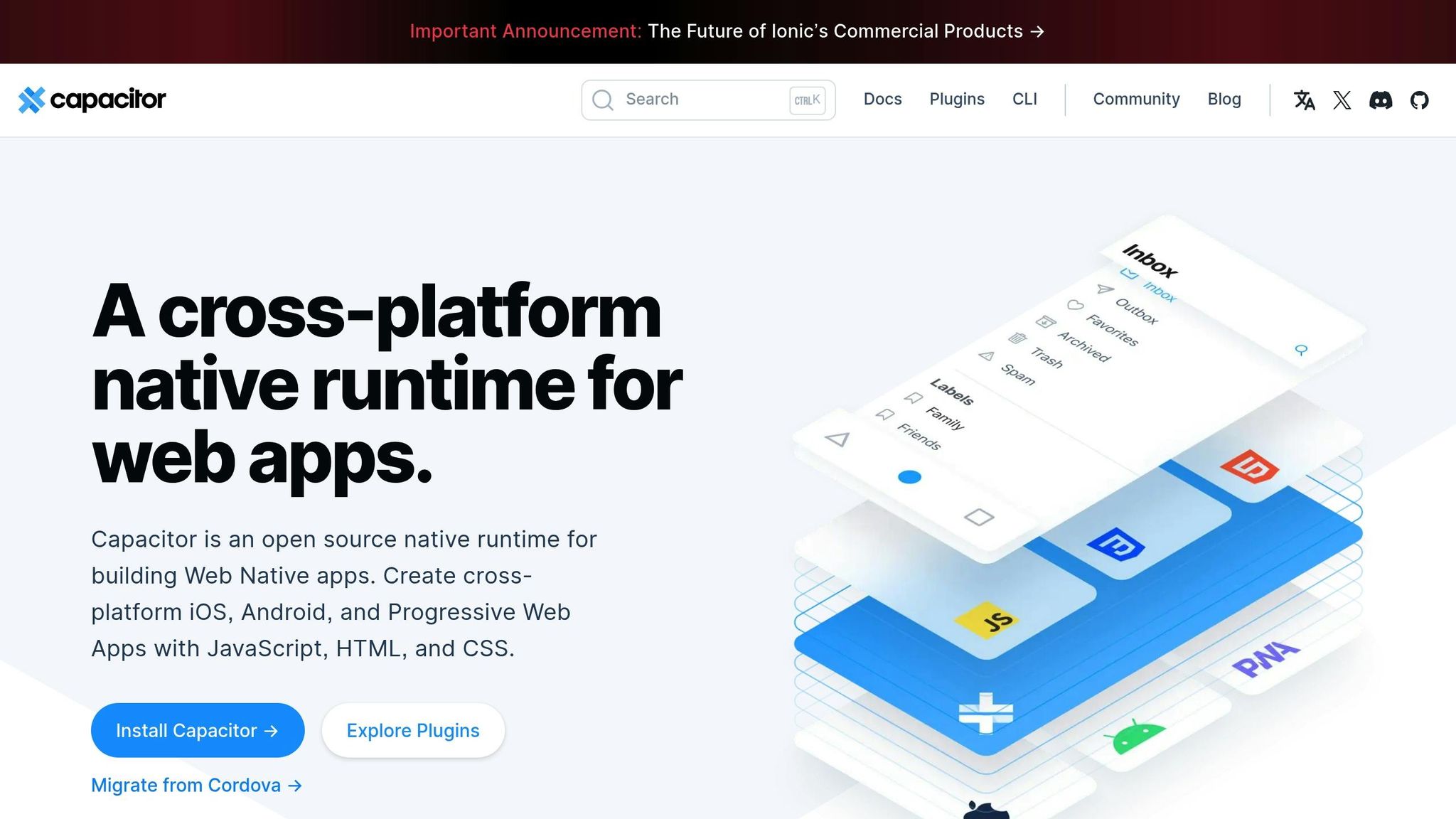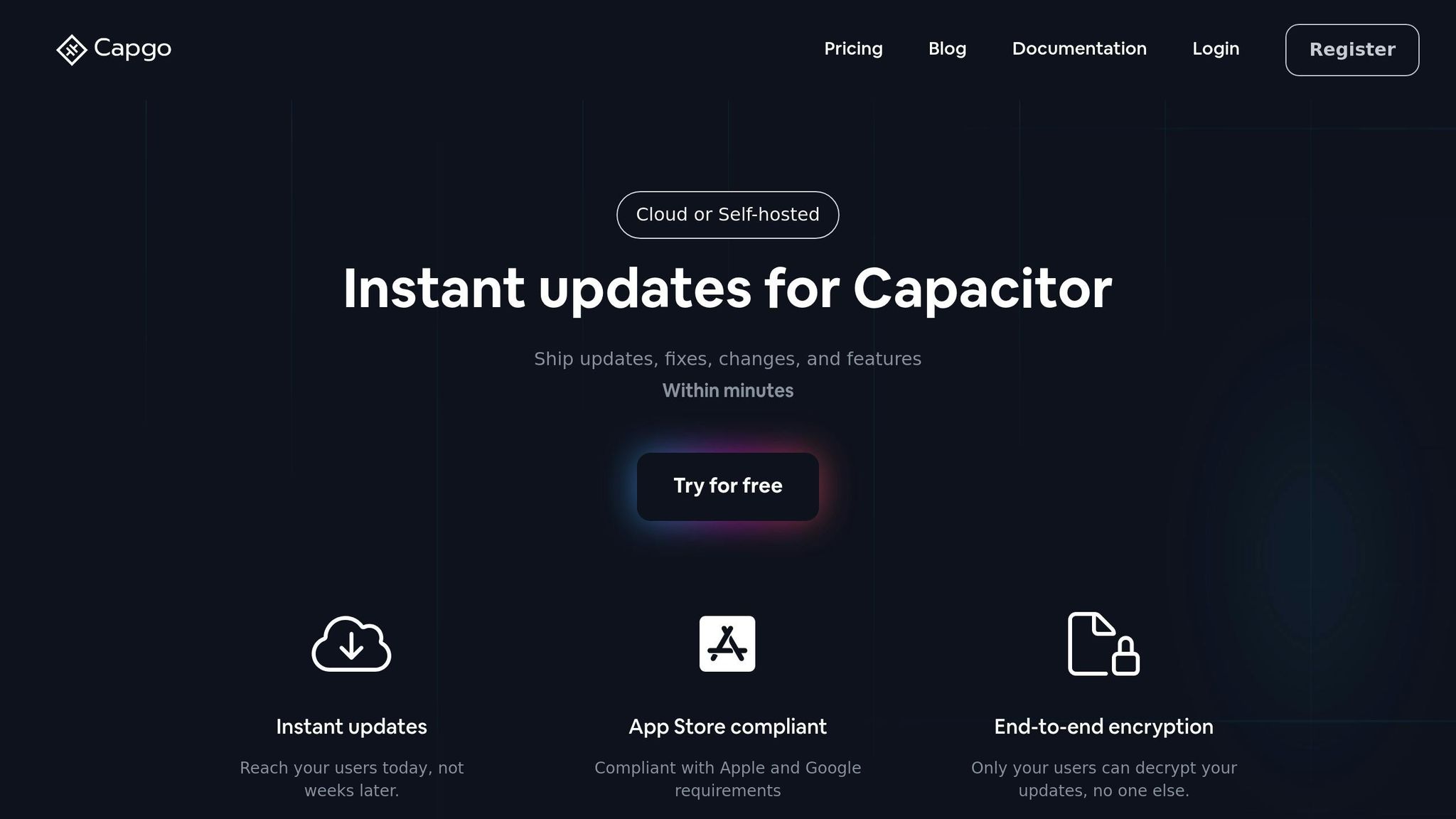Struggling with Capacitor CLI errors? Here’s a quick guide to fixing common problems like plugin issues, build errors, and network problems. Capacitor CLI is essential for managing app updates, especially over-the-air (OTA) updates, which let you bypass app store reviews and push fixes faster. Below are the key takeaways:
-
Common Problems and Fixes:
- Missing Plugin Errors: Clear npm cache, update dependencies, and sync project files.
- Build Errors: Fix version mismatches, update Cocoapods/Gradle, and clear build caches.
- Live Update Issues: Check configurations, network connections, and version numbers.
- Network Problems: Solve SSL, timeout, or proxy issues with smart update tools.
-
Prevention Tips:
- Keep projects in sync with
npx cap sync,npx cap update, andnpx cap doctor. - Reset build files to fix unexpected behavior.
- Align version numbers across all Capacitor components.
- Keep projects in sync with
-
Tools for OTA Updates:
- Use platforms like Capgo for encrypted, partial updates with background installation and channel-based rollouts.
Quick Fix Table:
| Issue | Fix Command/Action | Platforms |
|---|---|---|
| Missing Plugins | Clear npm cache, sync files | iOS & Android |
| Xcode Build Failures | pod install | iOS |
| Gradle Sync Issues | Clear .gradle cache | Android |
| Version Mismatch | Update all Capacitor packages | iOS & Android |
Bottom Line: Managing CLI commands effectively ensures smooth updates and better app performance. Tools like Capgo simplify deployments and reduce errors. Follow these steps to keep your app running smoothly.
How to Fix Quasar-Framework and Capacitor Dev Command …

Main CLI Command Problems
Developers often face challenges with Capacitor CLI commands, which can disrupt workflows. Here’s a breakdown of common issues and how to tackle them.
Missing Plugin Errors
Sometimes plugins fail to load, usually because dependencies aren’t properly installed or synchronized. For instance, the ‘@capacitor/live-updates’ plugin might not load, stopping updates in their tracks.
Here’s how to fix plugin errors:
- Clear your npm cache
- Update your dependencies
- Synchronize your project files
Let’s move on to problems that can arise during app builds.
App Build Errors
Build errors typically happen due to version mismatches between Capacitor components or misconfigurations that interfere with OTA updates.
| Platform | Common Error | Solution |
|---|---|---|
| iOS | Xcode build failure | Update Cocoapods and run pod install |
| Android | Gradle sync failed | Clear the Gradle cache and update Android Studio |
| Both | Version mismatch | Ensure all Capacitor packages are using the same version |
Live Update Errors
Deploying live updates can sometimes result in errors that affect app reliability and update delivery. Capgo’s encryption and intelligent update systems help reduce these issues, but they can still happen.
If you run into live update errors, try these steps:
- Double-check your update configuration
- Test your network connection
- Ensure version numbers are correct
Network-related problems can also play a role in live update issues.
Network and Event Issues
Network problems can block updates and cause event handling errors. These are some common culprits:
- Timeout errors
- SSL certificate issues
- Proxy misconfigurations
Using smart differential updates can reduce bandwidth usage and make updates more reliable, even on slower networks [1].
CLI Error Prevention Tips
Avoid common command-line interface (CLI) issues by following these practical strategies. These tips can help ensure a smoother development process.
Keep Projects in Sync
Keeping your project in sync reduces the chance of running into CLI errors. Use the following commands to maintain consistency between your web assets and native platforms:
npx cap sync: Keeps web assets and native platforms aligned after changes.npx cap update: Updates your Capacitor installation when new versions are released.npx cap doctor: Verifies plugin installations and checks for potential issues.
“The community needed this and @Capgo is doing something really important!” - Lincoln Baxter [1]
If you encounter persistent issues, clearing build caches is the next step.
Reset Build Files
Unexpected behavior from CLI commands often stems from build cache issues. Clear these caches for each platform using the steps below:
| Platform | Reset Steps | When to Use |
|---|---|---|
| iOS | Run pod deintegrate followed by pod install | After CocoaPods conflicts |
| Android | Clear the .gradle cache and delete the build folder | When Gradle sync fails |
| Web | Remove the node_modules folder and run npm install | After dependency conflicts |
Clearing these caches can resolve many platform-specific problems.
Match Version Numbers
Version mismatches between Capacitor components are a common source of CLI errors. Ensuring all components are on compatible versions is critical for stability.
Here’s what to check:
- CLI version: Confirm using
npx cap --version. - Core package version: Verify in your
package.jsonfile. - Plugin versions: Check the dependency list for consistency.
When updating, align all related packages. For example, if upgrading @capacitor/core to version 5.0.0, update all other Capacitor plugins to the same major version.
Version mismatches can create subtle problems that may not show up immediately, so performing regular version audits can save you from future headaches.
OTA Update Tools
Managing OTA updates effectively requires tools that handle deployment, monitoring, and troubleshooting seamlessly. Since issues with command-line interfaces (CLI) often occur during updates, having the right tools is essential for smooth operations.
Using Capgo Updates

Capgo is a popular platform for handling Capacitor OTA updates, boasting an impressive delivery record of 1155.1 billion updates with an 82% global success rate [1]. It addresses common CLI challenges through the following features:
| Feature | Benefit | Technical Impact |
|---|---|---|
| End-to-End Encryption | Secures update delivery | Protects against man-in-the-middle attacks |
| Partial Updates | Saves bandwidth | Downloads only modified files |
| Background Installation | Requires no user input | Updates install automatically in the background |
| Channel System | Enables targeted rollouts | Distributes updates to specific user groups |
To get started with Capgo updates:
- Install the plugin: Use the command
npx @capgo/cli init. - Build your app: Proceed with your usual app build process.
- Deploy updates: Use Capgo’s CLI commands for deployment.
“We practice agile development and @Capgo is mission-critical in delivering continuously to our users!” – Rodrigo Mantica [1]
Once updates are deployed, rely on platform-specific debugging tools to ensure everything works as expected and to resolve any issues.
Debug Tools Guide
When diagnosing OTA update problems, platform-specific tools can be invaluable:
-
For Android:
- LogCat: Provides real-time logs for monitoring.
- Android Debug Bridge (ADB): Allows direct interaction with devices.
- Bundle Analyzer: Helps optimize update size.
-
For iOS:
- Xcode Console: Tracks update installation logs.
- Network Inspector: Monitors update download performance.
- Safari Web Inspector: Assists in debugging WebView issues.
Additionally, keep an eye on global CDN performance. For instance, Capgo’s CDN typically delivers 5MB bundles in just 114ms [1]. This benchmark can help determine whether issues are related to network conditions or implementation errors.
Conclusion
Managing CLI commands effectively is key to ensuring smooth app updates and delivering a great user experience. With the fast pace of OTA updates today, tools like Capgo provide reliable solutions to address common CLI challenges.
The methods and tools mentioned earlier help resolve these issues while supporting stronger deployment processes. To sum up, well-organized CLI management directly impacts update security, speed, and recovery. Capgo’s performance highlights the importance of efficient CLI practices [1].
| Aspect | Impact | Solution |
|---|---|---|
| Update Security | Prevents unauthorized access | End-to-end encryption |
| Deployment Speed | Reduces downtime | Global CDN |
| Error Recovery | Minimizes user impact | Instant rollback capability |
| Update Distribution | Ensures precise delivery | Channel-based deployment |
These elements tie into earlier strategies for preventing errors and debugging, creating a streamlined update process. Automated and secure update systems are setting new standards for CLI management. Strong CLI practices are essential for staying ahead in app development [1].




